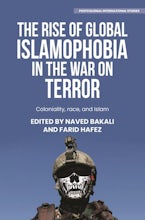- Home
- political science
- Jihad & Co.

Jihad & Co.
Black Markets and Islamist Power
By: Aisha Ahmad
336 Pages
- Hardcover
- ISBN: 9780190656775
- Published By: Oxford University Press
- Published: September 2017
$29.95
Using interviews as well as qualitative and some quantitative data analysis, in Jihad & Co., Aisha Ahmad uses the case studies in Afghanistan/Pakistan and Somalia to illustrate the main thesis of the book: that in areas where the state is weak and tribal loyalty is the main form of social capital, Islamists have the unique ability to leverage religious-based social capital that cuts across tribal lines. Thus, Ahmad argues, Islamists offer the local business community—oftentimes engaged in smuggling, narcotics, and arms trading—a one-stop protection alternative to tribal warlords who overtax the local population. Islamists become a cheaper alternative for local businessmen, who offer them financial support, and then come to regret it later once the Islamists monopolize power (sometimes as proto-states) and impose draconian puritanism on the helpless population. Later chapters of the book expand the analysis, using secondary sources, to similar war-torn areas in Syria, Iraq, and Mali. Finally, putting on her political scientist hat, Ahmad explains that the organized violence witnessed in these areas is not different from historical episodes in Europe that eventually led to the establishment of nation states that we observe today. Nonetheless, in a balanced tone of understanding and reproach, she notes how international outrage and intervention has often produced the opposite of their intended effects, and suggests instead focusing on reforming the incentive structures that local businesspeople face, which have contributed to the rise of Islamist proto-states.
The book is at its best in the historical narrative sections, which are peppered with quotations from insiders whom the author has interviewed in person. At times, the reader feels that the main thesis has been restated too many times, but this may not be a defect if we consider the potential assignment of individual chapters or sections as supplemental readings in various courses. There is also a marked disconnection between the narrative style throughout the book and the regression analysis using survey data from Somalia (the latter reads like a misplaced segment of an academic journal article), but it is easy for the uninterested reader to skip that segment.
For economists and political scientists, the book’s main focus on financial and/or power incentives of various parties is a welcome application of rational choice theory in policy and cultural debates about the problem of militant Islamism. It accomplishes this task well. However, the book seems to miss a number of opportunities to take the analysis further.
Ahmad asserts that the competing tribal chiefs or warlords cannot coordinate to collect an efficient level of taxes, while Islamists have the advantage of the ex ante trust of the community, as well as the ability to recruit across tribal barriers to consolidate power. However, there must be numerous religious figures who can market different variations of Islamism (as we have seen clearly in Syria, for example, where several brands of Islamism are marketed, including AQ Salafi and ISIS Salafi, alongside older MB and Shi`a brands, with each group having its own domestic and foreign supporters). Why can those Islamists coordinate while the tribal leaders cannot? The author does a good job of explaining how most of those who start or join the Islamist cause with sincere moral intention eventually get captured by the same wealth and power drunkenness that plagues other groups. But when warlords see that a charismatic preacher is successfully capturing some of their extortion/protection market share, why can they not use the same businessman playbook that the author describes—showing external signs of religiosity, coopting some preachers, and so forth, to cultivate their own religious social capital?
Another opportunity that Ahmad missed is taking the rational choice analysis a step further by examining the incentive structures of authorities who create and maintain market distortions (tariff rules between Pakistan and Afghanistan, for example) that give rise to smuggling and other criminal trade opportunities in the first place, and the incentives of authorities elsewhere who face difficult choices. Policy recommendations at the end of the book seem to assume a utopian policy world where regional and global governments are monolithic and share the common objectives of the author herself, but who have simply not noticed the important role of the intranational financial support that such Islamist groups need to receive voluntarily from business communities in order to succeed. Ahmad closes her last chapter by bemoaning the international community’s irrational impulse to “do something” and the even more irrational inclination to do things like “toppling governments,” which she characterizes as “dangerous, foolish, illegal, and immoral.” She attributes this ostensibly irrational and immoral behavior to a combination of pride and impatience. Surely, making such assertions requires careful analysis of the incentives and time-horizons of the accused parties and Ahmad herself. This is the predicament of all post hoc rational choice analyses, including this one and any potential sequels. Nonetheless, leaving Ahmad’s derived policy conclusions aside, the analysis itself is quite valuable.
Mahmoud el-Gamal is Professor of Economics and Statistics at Rice University.
Mahmoud El-GamalDate Of Review:February 26, 2018
Aisha Ahmad is assistant professor of political science at the University of Toronto.











